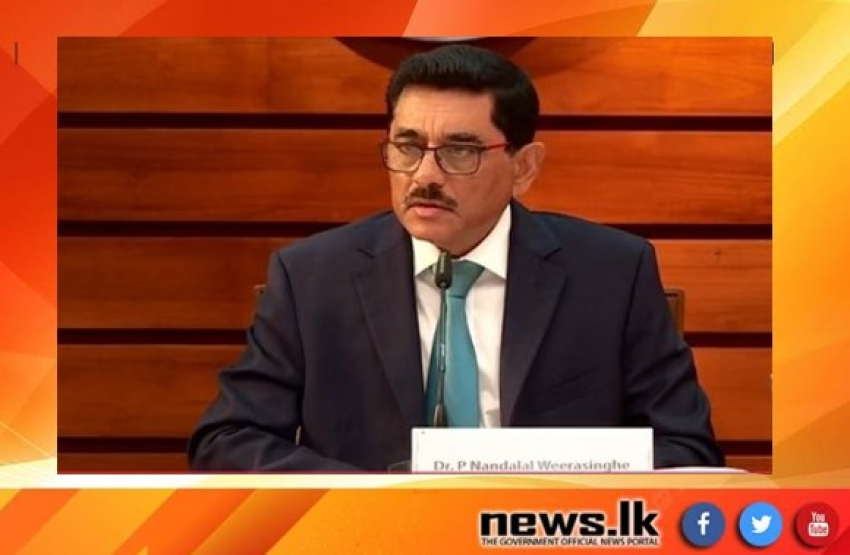During a special press briefing held at the Presidential Media Centre on Domestic Debt Optimization (DDO), Dr. Nandalal Weerasinghe, the Governor of the Central Bank, emphasized the importance of relieving the burden on the banking system caused by the already excessive 50% taxes. This measure aims to safeguard the treasury, strengthen the economy, and ensure the protection of the 57 million public and private bank deposits in Sri Lanka.
The Governor highlighted the severe repercussions that would result from a collapse in the country's banking sector. To prevent such a scenario, Friday, June 30th, was declared a bank holiday until the Parliament approves the restructuring of local debt.
Furthermore, Dr. Nandalal Weerasinghe assured the public that the existing Employee Provident Fund (EPF) would remain untouched. Additionally, he guaranteed a minimum interest rate of 9% for the EPF.
In attendance at the press conference were Dr. R.H.S. Samaratunga, the Senior Advisor to the President on Economic Affairs, Mr. Mahinda Siriwardena, the Secretary of the Finance Ministry, Mr. A.K. Seneviratne, the Deputy Treasury Secretary, as well as heads of media organizations and media representatives.
Dr. Nandalal Weerasinghe, the Governor of the Central Bank, further commented on the DDO;
In order to achieve a sustainable level of the government's domestic debt, we must work towards stabilizing the current criteria within a 10-year timeframe, as agreed upon with the International Monetary Fund (IMF). For instance, by the end of 2022, the public debt as a percentage of the Gross Domestic Product (GDP) stood at 128%. However, our target is to reduce it to below 95% by 2032, which is the first criterion. The second criterion involves reducing the government's total financing requirement, currently at 34.6% of the GDP annually, to an average level of 13% or lower during the 5 year period of 2027-2032.
The third criterion pertains to foreign debt servicing, which currently accounts for 9.4% of the GDP. Our aim is to bring it down to 4.5% during the period of 2027-2032. Achieving these goals will lead to a reduction of $16.9 billion in the relief required to bridge the external financing gap. Additionally, there are three other tasks that need to be accomplished in order to attain these three objectives.
There are three key aspects to address in the debt restructuring process. Firstly, discussions are underway regarding the restructuring of official bilateral debts. Secondly, there are on-going discussions regarding the money borrowed through sovereign bonds in commercial markets. Thirdly, there is a focus on optimizing domestic debt. The optimization of domestic credit plays a significant role in this overall process.
Through the restructuring of local debts, the aim is to reduce the government's gross debt burden and meet its financial needs. If the proposed measures are implemented, it is projected that the gross financial need will decrease to 12.7, aiming for a value below 13. If successfully implemented, this would result in a reduction of public debt as a percentage of the gross domestic product, bringing it down to 90%.
Currently, there are 4.1 trillion in treasury bills, with 62.4% held by the Central Bank. Conversion of treasury bills into long-term treasury bonds has been proposed previously. However, additional measures are required, prompting consideration of treasury bonds to fulfil the remaining financial requirements. Presently, there are 8.7 trillion in treasury bonds, with 36.5% held by the superannuation fund and approximately 36% held by banks. The remaining portion is owned by insurance companies and private individuals.
As the Central Bank, our primary concern is to find the best solution to ensure the stability of the banking system and the well-being of the Employee Provident Fund (EPF). The Central Bank, being the custodian of the EPF, actively participates in discussions and supports the proposed measures to safeguard deposits and protect public funds such as the EPF from any potential harm.
According to the proposal, the banking system has already made a significant contribution to reducing the government's indebtedness. Currently, banks pay over 50% of their income as taxes, including 30% as company tax, 18% as VAT and financial services tax, and 2.5% as social security contribution. Therefore, more than 50% of the banks' earnings are already allocated to taxes and contribute to the government's revenue. In comparison, superannuation funds have a lower tax rate of 14%.
Hence, the first point to note is that the banking system is already making a considerable contribution.
Secondly, the banking system has incurred losses due to non-payment of loans resulting from economic challenges and grace periods provided. In the past, grace periods with a value of 1.6 trillion were granted, indicating that the banking system has already contributed to the economy.
Protecting the banking system and ensuring the safety of depositors' funds are crucial responsibilities. The banking system plays a vital role in the economy, as evidenced by the 57 million bank accounts holding deposits from a population of around 20 million. Any harm to these funds would have a severe impact on the banking system. As the Central Bank, our primary objective is to safeguard the banking system and the currency. Recently, there were rumours about bank collapses, and concerns were raised regarding the safety of deposits. Withdrawing deposits from banks would lead to an economic collapse.
Therefore, the foremost effort is to protect the funds of depositors in the 57 million accounts without harming the banking system, as it would have the greatest social impact. Consequently, the banks should not be further burdened.
Moving on to the superannuation funds, which include the Employee Provident Fund (EPF) and the Employees' Trust Fund (ETF), they are subject to a 14% tax rate, which is lower than the tax rate imposed on banks. The proposal suggests retrieving all existing treasury bonds from these funds and issuing new bonds in return. These bonds will earn 12% interest until 2025 and 9% interest thereafter. Importantly, the amount in the EPF will not decrease, as the government guarantees a future benefit of 9% interest. The government assures that if there is any deficit, the treasury will cover it.
Those who choose not to participate in the Treasury bond exchange have the option of paying a 30% tax instead of the standard 14% tax.
We aim to complete the bond exchange within a few weeks and finalize this process in July.
Finance Ministry Secretary Mahinda Siriwardena;
The domestic debt restructuring proposal has been officially submitted to the Cabinet and subsequently approved. Currently, it is being processed for submission to Parliament and is expected to receive approval by Saturday. It is widely acknowledged that public debt restructuring is a crucial matter, especially considering the International Monetary Fund's declaration of Sri Lanka's unsustainable debt. This restructuring involves both domestic and foreign loans. Although the foreign debt restructuring program is underway, significant emphasis has been placed on prioritizing the completion of the domestic debt restructuring program in a timely manner.
President’s Senior Economic Advisor Dr. R.H.S. Samaratunga
“Following the government's decision to seek support from the International Monetary Fund (IMF), a staff-level agreement was reached in September of the previous year. However, the IMF has stated that the proposal cannot be implemented until Sri Lanka's debt sustainability is established.
As a result, extensive discussions took place between the government and international creditors from September 1st to March 20th. The primary objective was to obtain a financing certificate from these lenders, and we successfully completed this process in the second week of March. Consequently, by March 20th, the IMF agreed to accept our request and proceed further.
This program is designed to run for a period of four years and consists of five key elements. Firstly, there is a focus on revenue-based fiscal consolidation, particularly due to the significant drop in the country's gross domestic product to 8% in 2020-2021. This element involves enhancing tax collection and addressing related issues.
Secondly, debt restructuring is a critical aspect as highlighted by the IMF, which has raised concerns about Sri Lanka's debt sustainability. The third element pertains to establishing price stability within the country. Fourthly, it is crucial to preserve the stability of the financial sector. Lastly, the government needs to adopt an anti-corruption policy. These goals require the implementation of structural reforms.
With regard to these elements, the government has already implemented policies on various matters apart from debt restructuring. The total domestic debt discussed today amounts to 42.1 billion US dollars, out of which 19.8 billion will be allocated for restructuring. This includes debt owed to the Central Bank of Sri Lanka, commercial banks, other banks, the Employees Provident Fund, and four other institutions that have provided loans to the government.
While debt restructuring among these institutions will occur through different methods, the ultimate aim is to provide the government with some relief through a mixed program.”
In addition, journalists raised several questions regarding the Domestic Debt Optimization measures to which the officials responded.
Question;
There are varying opinions within the country concerning the Employee Provident Fund and how the funds received are handled at the end. Some advocate for the funds to be managed under the existing Treasury bill system, while others support the proposed 30% tax system, in either situation what happens to the funds?
Dr. Nandalal Weerasinghe
At present, the amount received by the beneficiaries of the Employee Provident Fund remains unaffected, and they continue to earn a 9% interest on their investments. Consequently, there is no disparity between the current scenario and the proposed future arrangement. However, if the 30% tax is not paid, it might hinder the ability to provide the 9% interest. In such a situation, a lower interest rate of 7% or 8% might be applicable.
Therefore, it is crucial to make the most optimal decision for the members of the Employee Provident Fund. We firmly believe that it is feasible to sustain the 9% interest rate while ensuring the fund's collection remains intact.
Question
Given the varying opinions surrounding the debt restructuring program, it is inevitable that differing perspectives will arise. In response to this, has the government developed a program to effectively communicate the accurate situation and foster a sense of social awareness?
Mr. Mahinda Siriwardena;
Taking action today to educate and inform the public about the current situation is crucial. Many questions are being raised, including concerns about the potential collapse of the banking system and the adverse impact on the country. This is a distressing situation for me personally, as the nation is facing significant challenges that are yet to be resolved. It is imperative to implement programs that can help overcome these challenges.
Our priority is to safeguard both the banking system and the Employee Provident Fund, ensuring fairness for all. It is essential to disseminate information widely about these programs, particularly reaching out to impoverished individuals in remote villages who may be unaware or unable to participate actively. Furthermore, it is crucial to understand that without restructuring domestic debt, foreign debt restructuring will not be feasible.
Currently, we have entered into a program with the International Monetary Fund, and failing to pursue debt restructuring will have repercussions on this program. The consequences for the future of our country under such circumstances are unimaginable. Therefore, it is vital to recognize the sensitivity of this issue and address it accordingly.
Question
For several years, there has been an acknowledgment of the lack of debt sustainability in Sri Lanka. In light of this, it raises questions as to why there was an increase in investments in bonds issued by the Employee Provident Fund.
Dr. Nandalal Weerasinghe;
In 2020, even the International Monetary Fund acknowledged the lack of debt sustainability in Sri Lanka. Subsequently, in 2021, the proposal for debt restructuring was introduced.
Considering the investments within the country, there arises a question regarding alternative investment options for the funds allocated to the Employee Provident Fund. Approximately Rs. 500 million is contributed to the Employee Provident Fund annually. It is not only the Employee Provident Fund but also the insurance fund that should be invested in Sri Lanka. As such a substantial amount cannot be solely invested in the stock market. When the government faces difficulties in repaying its debts, it unfortunately resorts to using treasury bills.
This situation highlights the need to address the existing challenges and find sustainable solutions for prudent investment management.
Question
Can individuals access the Employee Provident Funds upon retirement?
Mr. Nandalal Weerasinghe
Certainly. There are no obstacles in availing the funds. Once the Employee reaches retirement, they are eligible to receive the EPF funds owed to them.
President’s Media Division (PMD)



















